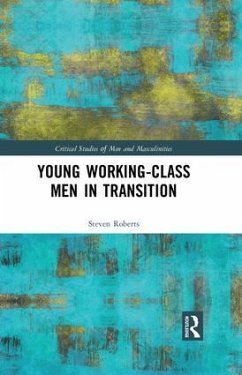Steven Roberts
Young Working-Class Men in Transition
Steven Roberts
Young Working-Class Men in Transition
- Gebundenes Buch
- Merkliste
- Auf die Merkliste
- Bewerten Bewerten
- Teilen
- Produkt teilen
- Produkterinnerung
- Produkterinnerung
Young Working Class Men in Transition uses a unique blend of concepts from the sociologies of youth and masculinity combined with Bourdieusian social theory to investigate British young working-class men's transition to adulthood.
Andere Kunden interessierten sich auch für
![The Social Analysis of Class Structure The Social Analysis of Class Structure]() Frank ParkinThe Social Analysis of Class Structure174,99 €
Frank ParkinThe Social Analysis of Class Structure174,99 €![Labour and Working Class History in Atlantic Canada Labour and Working Class History in Atlantic Canada]() Labour and Working Class History in Atlantic Canada27,99 €
Labour and Working Class History in Atlantic Canada27,99 €![What About Men? What About Men?]() Caitlin MoranWhat About Men?12,99 €
Caitlin MoranWhat About Men?12,99 €![What About Men? What About Men?]() Caitlin MoranWhat About Men?8,99 €
Caitlin MoranWhat About Men?8,99 €![Shop Class as Soulcraft Shop Class as Soulcraft]() Matthew B. CrawfordShop Class as Soulcraft15,99 €
Matthew B. CrawfordShop Class as Soulcraft15,99 €![Comparability in Social Research Comparability in Social Research]() Comparability in Social Research132,99 €
Comparability in Social Research132,99 €![Diversity and Decomposition in the Labour Market Diversity and Decomposition in the Labour Market]() Diversity and Decomposition in the Labour Market103,99 €
Diversity and Decomposition in the Labour Market103,99 €-
-
-
Young Working Class Men in Transition uses a unique blend of concepts from the sociologies of youth and masculinity combined with Bourdieusian social theory to investigate British young working-class men's transition to adulthood.
Hinweis: Dieser Artikel kann nur an eine deutsche Lieferadresse ausgeliefert werden.
Hinweis: Dieser Artikel kann nur an eine deutsche Lieferadresse ausgeliefert werden.
Produktdetails
- Produktdetails
- Verlag: Taylor & Francis Ltd (Sales)
- Seitenzahl: 240
- Erscheinungstermin: 28. Juni 2018
- Englisch
- Abmessung: 234mm x 156mm x 14mm
- Gewicht: 517g
- ISBN-13: 9781138217188
- ISBN-10: 1138217182
- Artikelnr.: 54077624
- Herstellerkennzeichnung
- Libri GmbH
- Europaallee 1
- 36244 Bad Hersfeld
- gpsr@libri.de
- Verlag: Taylor & Francis Ltd (Sales)
- Seitenzahl: 240
- Erscheinungstermin: 28. Juni 2018
- Englisch
- Abmessung: 234mm x 156mm x 14mm
- Gewicht: 517g
- ISBN-13: 9781138217188
- ISBN-10: 1138217182
- Artikelnr.: 54077624
- Herstellerkennzeichnung
- Libri GmbH
- Europaallee 1
- 36244 Bad Hersfeld
- gpsr@libri.de
Steven Roberts is an Associate Professor in Sociology, School of Social Sciences, Faculty of Arts, Monash University, Australia
Acknowledgements
Preface
Chapter 1
Youth Transitions, Young Men and Social Change
Introduction
Youth transitions and social change
Outline of the book
Chapter 2
Dominant representations of working-class masculinity: the so-called
'crisis of masculinity' and the academic response
Introduction
The so-called 'crisis of masculinity': A prominent, problematic, durable
discourse
Not exactly a 'crisis': Sociology's reflections on changes, challenges and
continuities to masculinity in new times
Changing circumstances, changing working-class masculinity?
A relatively singular account of masculinity across variations in place
and space
Conclusion
Chapter 3
Making sense of men: outlining a framework for the study of contemporary
masculinities
Introduction
Social Constructionism vs Post-Structuralism: a genuinely entrenched
binary?
Connell's theory of Hegemonic Masculinity
Critiques of Hegemonic Masculinity Theory
The constraints of HMT's deterministic outlook
Theorising change: Anderson's Inclusive Masculinity Theory
Anderson's concept of homohysteria
Critiques of IMT
Making the most of Mannheim's legacy: masculinities and the sociology
of generations
Bringing in Bourdieu: a fuller account of the social actor
Conclusion
Chapter 4
The study context and methods
Introduction
The research sites
Accessing the sample
The research process
Chapter 5
Looking back and looking forward at age 18-24: educational histories and
aspirations
Introduction
Underachieving and disengaged boys?
School days: Just an 'in-betweener'
'Ordinariness' and alienated instrumentalism
Post-16 'choices'
Critical moments in post-16 education engagement and drop out
Higher education: Awareness, aspirations, ambitions
Conclusion
Chapter 6
Young working class men navigating the precarious world of work: identity
in and out of the labour market
Introduction
Embracing service work: the new normal for young working-class men
Working-class young men's working lives
Sources of identity beyond the sphere of employment
Conclusion
Chapter 7
Contemporary Working-class Masculinities and the Domestic Sphere: the
diminishing significance of 'the man of the house'
Introduction
Domesticity, Gender Roles and Social Class
Attitudes and imagined futures at age 18-24
Walking the walk, not just talking the talk: Gender dynamics in the home,
seven years later
Conclusion
Chapter 8
Emotional disclosure online and offline: changes and continuities in forms
of intimate expression among working-class men
Introduction
Emotion in abundance: an unexpected observation?
Sharing emotional content in research interviews
Emotion-laden activity on Facebook
'It's just between mates': Making sense of misogyny and homosexually
themed language
Conclusion
Chapter 9
Conclusion: Changing the tune, but not changing the record: Working-class
masculinity in transition
Introduction
Myth busting: the key findings
The transformed working class habitus
Practical implications
Preface
Chapter 1
Youth Transitions, Young Men and Social Change
Introduction
Youth transitions and social change
Outline of the book
Chapter 2
Dominant representations of working-class masculinity: the so-called
'crisis of masculinity' and the academic response
Introduction
The so-called 'crisis of masculinity': A prominent, problematic, durable
discourse
Not exactly a 'crisis': Sociology's reflections on changes, challenges and
continuities to masculinity in new times
Changing circumstances, changing working-class masculinity?
A relatively singular account of masculinity across variations in place
and space
Conclusion
Chapter 3
Making sense of men: outlining a framework for the study of contemporary
masculinities
Introduction
Social Constructionism vs Post-Structuralism: a genuinely entrenched
binary?
Connell's theory of Hegemonic Masculinity
Critiques of Hegemonic Masculinity Theory
The constraints of HMT's deterministic outlook
Theorising change: Anderson's Inclusive Masculinity Theory
Anderson's concept of homohysteria
Critiques of IMT
Making the most of Mannheim's legacy: masculinities and the sociology
of generations
Bringing in Bourdieu: a fuller account of the social actor
Conclusion
Chapter 4
The study context and methods
Introduction
The research sites
Accessing the sample
The research process
Chapter 5
Looking back and looking forward at age 18-24: educational histories and
aspirations
Introduction
Underachieving and disengaged boys?
School days: Just an 'in-betweener'
'Ordinariness' and alienated instrumentalism
Post-16 'choices'
Critical moments in post-16 education engagement and drop out
Higher education: Awareness, aspirations, ambitions
Conclusion
Chapter 6
Young working class men navigating the precarious world of work: identity
in and out of the labour market
Introduction
Embracing service work: the new normal for young working-class men
Working-class young men's working lives
Sources of identity beyond the sphere of employment
Conclusion
Chapter 7
Contemporary Working-class Masculinities and the Domestic Sphere: the
diminishing significance of 'the man of the house'
Introduction
Domesticity, Gender Roles and Social Class
Attitudes and imagined futures at age 18-24
Walking the walk, not just talking the talk: Gender dynamics in the home,
seven years later
Conclusion
Chapter 8
Emotional disclosure online and offline: changes and continuities in forms
of intimate expression among working-class men
Introduction
Emotion in abundance: an unexpected observation?
Sharing emotional content in research interviews
Emotion-laden activity on Facebook
'It's just between mates': Making sense of misogyny and homosexually
themed language
Conclusion
Chapter 9
Conclusion: Changing the tune, but not changing the record: Working-class
masculinity in transition
Introduction
Myth busting: the key findings
The transformed working class habitus
Practical implications
Acknowledgements
Preface
Chapter 1
Youth Transitions, Young Men and Social Change
Introduction
Youth transitions and social change
Outline of the book
Chapter 2
Dominant representations of working-class masculinity: the so-called
'crisis of masculinity' and the academic response
Introduction
The so-called 'crisis of masculinity': A prominent, problematic, durable
discourse
Not exactly a 'crisis': Sociology's reflections on changes, challenges and
continuities to masculinity in new times
Changing circumstances, changing working-class masculinity?
A relatively singular account of masculinity across variations in place
and space
Conclusion
Chapter 3
Making sense of men: outlining a framework for the study of contemporary
masculinities
Introduction
Social Constructionism vs Post-Structuralism: a genuinely entrenched
binary?
Connell's theory of Hegemonic Masculinity
Critiques of Hegemonic Masculinity Theory
The constraints of HMT's deterministic outlook
Theorising change: Anderson's Inclusive Masculinity Theory
Anderson's concept of homohysteria
Critiques of IMT
Making the most of Mannheim's legacy: masculinities and the sociology
of generations
Bringing in Bourdieu: a fuller account of the social actor
Conclusion
Chapter 4
The study context and methods
Introduction
The research sites
Accessing the sample
The research process
Chapter 5
Looking back and looking forward at age 18-24: educational histories and
aspirations
Introduction
Underachieving and disengaged boys?
School days: Just an 'in-betweener'
'Ordinariness' and alienated instrumentalism
Post-16 'choices'
Critical moments in post-16 education engagement and drop out
Higher education: Awareness, aspirations, ambitions
Conclusion
Chapter 6
Young working class men navigating the precarious world of work: identity
in and out of the labour market
Introduction
Embracing service work: the new normal for young working-class men
Working-class young men's working lives
Sources of identity beyond the sphere of employment
Conclusion
Chapter 7
Contemporary Working-class Masculinities and the Domestic Sphere: the
diminishing significance of 'the man of the house'
Introduction
Domesticity, Gender Roles and Social Class
Attitudes and imagined futures at age 18-24
Walking the walk, not just talking the talk: Gender dynamics in the home,
seven years later
Conclusion
Chapter 8
Emotional disclosure online and offline: changes and continuities in forms
of intimate expression among working-class men
Introduction
Emotion in abundance: an unexpected observation?
Sharing emotional content in research interviews
Emotion-laden activity on Facebook
'It's just between mates': Making sense of misogyny and homosexually
themed language
Conclusion
Chapter 9
Conclusion: Changing the tune, but not changing the record: Working-class
masculinity in transition
Introduction
Myth busting: the key findings
The transformed working class habitus
Practical implications
Preface
Chapter 1
Youth Transitions, Young Men and Social Change
Introduction
Youth transitions and social change
Outline of the book
Chapter 2
Dominant representations of working-class masculinity: the so-called
'crisis of masculinity' and the academic response
Introduction
The so-called 'crisis of masculinity': A prominent, problematic, durable
discourse
Not exactly a 'crisis': Sociology's reflections on changes, challenges and
continuities to masculinity in new times
Changing circumstances, changing working-class masculinity?
A relatively singular account of masculinity across variations in place
and space
Conclusion
Chapter 3
Making sense of men: outlining a framework for the study of contemporary
masculinities
Introduction
Social Constructionism vs Post-Structuralism: a genuinely entrenched
binary?
Connell's theory of Hegemonic Masculinity
Critiques of Hegemonic Masculinity Theory
The constraints of HMT's deterministic outlook
Theorising change: Anderson's Inclusive Masculinity Theory
Anderson's concept of homohysteria
Critiques of IMT
Making the most of Mannheim's legacy: masculinities and the sociology
of generations
Bringing in Bourdieu: a fuller account of the social actor
Conclusion
Chapter 4
The study context and methods
Introduction
The research sites
Accessing the sample
The research process
Chapter 5
Looking back and looking forward at age 18-24: educational histories and
aspirations
Introduction
Underachieving and disengaged boys?
School days: Just an 'in-betweener'
'Ordinariness' and alienated instrumentalism
Post-16 'choices'
Critical moments in post-16 education engagement and drop out
Higher education: Awareness, aspirations, ambitions
Conclusion
Chapter 6
Young working class men navigating the precarious world of work: identity
in and out of the labour market
Introduction
Embracing service work: the new normal for young working-class men
Working-class young men's working lives
Sources of identity beyond the sphere of employment
Conclusion
Chapter 7
Contemporary Working-class Masculinities and the Domestic Sphere: the
diminishing significance of 'the man of the house'
Introduction
Domesticity, Gender Roles and Social Class
Attitudes and imagined futures at age 18-24
Walking the walk, not just talking the talk: Gender dynamics in the home,
seven years later
Conclusion
Chapter 8
Emotional disclosure online and offline: changes and continuities in forms
of intimate expression among working-class men
Introduction
Emotion in abundance: an unexpected observation?
Sharing emotional content in research interviews
Emotion-laden activity on Facebook
'It's just between mates': Making sense of misogyny and homosexually
themed language
Conclusion
Chapter 9
Conclusion: Changing the tune, but not changing the record: Working-class
masculinity in transition
Introduction
Myth busting: the key findings
The transformed working class habitus
Practical implications








